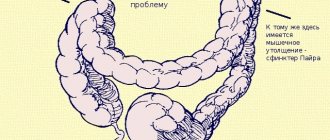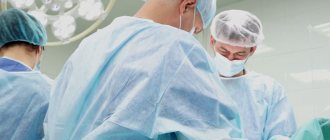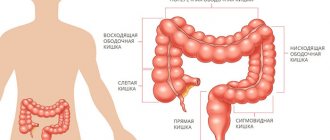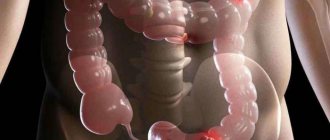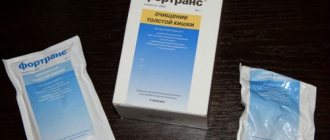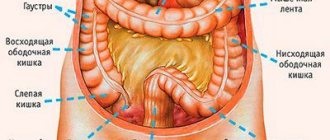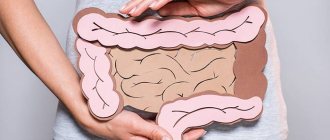Constipation (constipation, obstipation)
print version- home
- >
- For patients
- >
- Symptoms
- >
- Constipation
Constipation
(
constipation
) is a disturbance in bowel function with retention of stool for more than 48 hours, the release of hard feces, often accompanied by a feeling of tension and discomfort.
Obstipation
called more severe constipation, with the formation of dense, hardened stool. As a rule, with constipation, independent defecation is impossible.
When diagnosing constipation, doctors use the definition of the Rome III Consensus (2006) on the problems of functional gastrointestinal diseases. The definition of constipation includes the following symptoms:
- less than three bowel movements per week;
- separation of feces of high density;
- lack of feeling of complete bowel movement after bowel movement;
- presence of a feeling of blockage of contents in the rectum during pushing;
- the need for strong pushing;
- the need for digital removal of contents from the rectum, support of the pelvic floor with fingers, etc.
Constipation is a common health disorder and is especially common in young children and the elderly .
In addition to stool retention itself, chronic constipation can manifest itself as signs of dyspepsia - decreased appetite, heartburn, nausea, abdominal pain, flatulence.
With chronic constipation, intoxication of the body occurs, which is manifested by a general deterioration in well-being - decreased tone, fatigue, general malaise, increased irritability, sleep disturbances, and headaches.
Causes of constipation
Poor nutrition.
First of all, a diet poor in plant fibers, combined with a small amount of fluid intake. Irregular nutrition associated with the inability to build a daily routine and frequent business trips.
Wrong lifestyle
, as a rule, sedentary, without sufficient physical activity. This leads to congestion in the pelvis and muscle flaccidity.
Diseases of the gastrointestinal tract
- stomach ulcer, duodenal ulcer, chronic pancreatitis, irritable bowel syndrome, colon tumors, accumulation of hardened feces in the intestines (“fecal stones”).
Anal diseases
- anal fissures, hemorrhoids, accompanied by severe pain and preventing bowel movements.
Neurological diseases
- stroke, Parkinson's disease, spinal cord injuries and tumors, multiple sclerosis.
Endocrine system diseases
- hypothyroidism, diabetes mellitus, etc.
Taking certain medications
- atropine, baking soda, almagel, cocaine, etc.
Pregnancy.
Long-term depression.
Methods for diagnosing constipation and its causes
Clinical examination of the patient includes collection of complaints, anamnesis of life and illness, and physical examination.
Laboratory tests are being carried out
- complete blood count, stool test, blood test for thyroid hormone levels.
Instrumental examination helps to clarify the causes of constipation.
- endoscopic, x-ray. To study the motor function of the colon, anorectal manometry is performed (it is also prescribed for fecal incontinence, to confirm the diagnosis of megacolon and megarectum).
Treatment of constipation
- a diet that includes foods rich in plant fiber: vegetables, fruits, coarse black bread (sometimes specifically food bran) and at least 2 liters of liquid per day, you need to eat regularly, at least 5 times a day;
- physical education classes;
- medicinal (oil with fish oil, sunflower oil, etc.) and cleansing enemas;
- withdrawal of drugs that weaken intestinal contractions (atropine, baking soda, almagel, some antidepressants);
- if the measures listed above are not effective enough, laxatives are prescribed;
- If persistent constipation is caused by an intestinal tumor, surgical treatment is necessary.
Preventing constipation
- Drink regularly 8-10 glasses of fluid every day; warm or hot drinks can make bowel movements easier;
- Eat foods high in fiber, such as bran bread, whole grain bread, raw vegetables, fresh or dried fruit, nuts and popcorn, more on this in the dietary guidelines for constipation;
- Reduce your intake of cheese, chocolate and eggs.
- drink plum or apple juice;
- Do physical exercises to make stool easier to pass. Walking helps a lot;
- avoid excessive tension;
- visit the toilet when you feel the urge to defecate, but at the same time avoid spending a long time in the toilet;
- be sure to try to go to the toilet in the morning, even at the cost of being late for work;
- strive for soft, easy-to-pass stool once a day!
Doctors classify constipation under category K59.0
in the International Classification of Diseases ICD-10.
Patient Materials
- Recommendations of the American Gastroenterological Association “Constipation. The essence of the problem":
- Part I
- Part II
- Constipation. Practical guidance from the World Organization of Gastroenterology
- Recommendations for correcting nutrition and lifestyle in children with constipation
- Non-drug measures for constipation
- 10 tips from the American College of Gastroenterology for constipation and fecal incontinence
- Ivashkin V.T., Shelygin Yu.A., Maev I.V., Sheptulin A.A., Aleshin D.V., Achkasov S.I., Baranskaya E.K., Kulikova N.D., Lapina T. L.L., Moskalev A.I., Osipenko M.F., Poluektova E.A., Simanenkov V.I., Trukhmanov A.S., Fomenko O.Yu., Shifrin O.S. Diagnosis and treatment of constipation in adults (Clinical recommendations of the Russian Gastroenterological Association and the Association of Coloproctologists of Russia). Russian Journal of Gastroenterology, Hepatology, Coloproctology. 2020;30(6):69–85.
- Constipation. Clinical recommendations. Age category: adults. RGA. ACRE. Ministry of Health of Russia. 2022
- Shulpekova Yu.O. Algorithm for the treatment of constipation of various origins // RMZh. - Volume 15. - No. 15. - 2007.
- Shulpekova Yu.O. Constipation and methods of its treatment // Breast cancer. Diseases of the digestive system. – 2006. – Volume 8. – No. 2. – pp. 90–96.
- Yanova O.B., Masharova A.A. Gastroesophageal reflux disease in combination with chronic constipation in elderly patients // Clinical gerontology. - Newdiamed. — Volume 14. — 2008.
- Parfenov A.I., Ruchkina I.N., Silvestrova S.Yu. Prevention and treatment of functional constipation in the light of the Rome III consensus // Breast Cancer. – 2006. – Volume 8. – No. 2. – page 109.
Resources for Healthcare Professionals
On the website GastroScan.ru in the “Literature” section there is a subsection “Constipation and diarrhea”, containing articles for healthcare professionals on this topic.
Video for medical students
Still from a lecture by Dr. med.
A.V. Bursikov “Clinical and additional methods of research of the gastrointestinal tract” for 2nd year students of the Ivanovo State Medical Academy (IvGMA) On the website GastroScan.ru in the “Video” section there are subsections “For doctors”, containing video recordings of reports, lectures, webinars in various areas of gastroenterology for healthcare professionals and “For medical students and residents”
, containing recordings of lectures and educational materials.
Why does post-Covid syndrome occur?
Coronavirus is an insidious disease that can affect almost all organs and systems:
- upper respiratory tract;
- bronchi and lungs;
- nervous system;
- gastrointestinal tract;
- cardiovascular system.
Post-Covid syndrome can occur regardless of the form of coronavirus in a person: latent, mild, moderate, severe or critical.
Currently, there are several hypotheses that try to explain the formation of post-Covid syndrome. One of them claims that pathological symptoms after coronavirus are manifestations of chronic thrombusculitis.
Everyone has heard of such a complication of coronavirus as pneumonia, which affects the lungs. However, this is far from the most common complication of infection. With COVID-19, severe pneumonia occurs in only a small proportion of patients. Much more common is inflammation of the walls of blood vessels in the brain, which can continue after coronavirus.
This hypothesis partially explains some symptoms of post-Covid syndrome, but not all. Modern medicine has yet to find the exact causes of its occurrence and fully evaluate the consequences.
Neurological disorders in the post-Covid period are based on a wide range of both immunological and non-immunological effects. Deputy Director for Scientific Work of the National Medical Research Center for Rehabilitation and Balneology of the Ministry of Health of Russia, Doctor of Medicine, shared his vision of the mechanisms of damage to the nervous system. Sciences, Professor Andrey Rachin.
Mechanisms - prerequisites for neurological consequences
Andrey Rachin, Deputy Director for Research, National Medical Research Center for Rehabilitation and Balneology of the Russian Ministry of Health, Doctor of Medicine. sciences, professor. Direct damage to the central nervous system, when literally a few days after the onset of the disease the patient develops coronavirus enteritis, meningitis, and encephalitis. Such cases have been described, but it is important to understand what features arise in the clinical picture after suffering from COVID-19.
Post-infectious immune-mediated mechanism: after some time, the patient develops demyelinating polyneuropathy, various variants of Guillain-Barré syndrome.
This is an indirect damage to the peripheral nervous system and muscle tissue. Similar variants of both polyneuropathic and myopathic syndromes are well described. In this case, both therapy for the new coronavirus infection and treatment are carried out according to the basic regimens that are used specifically for this category (therapeutic plasmapheresis, gammaglobulin therapy).
The development of a systemic inflammatory reaction, coagulopathy, which causes the subsequent appearance of musculoskeletal pain.
Post-infectious immune-mediated mechanism.
Long-COVID vs post-Covid syndrome
There is a difference between the concepts of Long-COVID and “post-Covid syndrome”. If symptoms appear during or after infection, persist for more than 12 weeks and are not explained by an alternative diagnosis, then we can talk about the presence of post-Covid syndrome.
Post-Covid syndrome is included in the concept of Long-COVID, which includes a protracted course of the acute period of up to 12 weeks and the manifestation of consequences, including neurological ones, after 12 weeks. Unfortunately, it is difficult to determine how long this post-Covid syndrome (and now a separate term “post-Covid neurological syndrome” has appeared) will last. Initially it was assumed that we would talk about the year. The possibility of a protracted course is now being discussed—certain symptoms in the patient may persist for up to 2–3 years.
By the way, various manifestations are possible. Neither patients nor doctors are completely able to predict what symptoms may occur at 14, 15, 16 weeks after the onset of the disease. Long-COVID is considered a multisystem disease, sometimes occurring even after a mild course. Post-Covid syndrome has also been called “truck driver syndrome”: by analogy with a heavy truck driver who is driving along a long unfamiliar path and does not always know what will be around the corner.
Main Manifestations Manifestations of post-Covid syndrome are quite diverse:
- attacks of pathological weakness,
- dyspnea,
- disturbances of smell and taste,
- a sharp decrease in exercise tolerance,
- blood pressure disorder,
- violation of thermoregulation,
- asthenia,
- sleep/wake cycle disorder,
- dizziness and headaches,
- unstable emotional state,
- chest tightness
- stool disorder,
- heart rhythm disturbance,
- loss of appetite,
- muscle pain, etc.
Among the main manifestations, a large block is occupied by pain syndromes (muscle, joint, headache), as well as cognitive impairment (inability to concentrate, memory impairment). The latter are called “brain fog” in the scientific literature. A separate type of medical cognitive rehabilitation is used here.
Now there is a big debate in scientific circles: does the new coronavirus infection cause specific disorders in the nervous system? It is believed that many nonspecific viruses ultimately provoke chronic fatigue syndrome, in which all manifestations of post-Covid syndrome occur: chest pain, shortness of breath, muscle pain, joint pain, headaches, pathological fatigue (asthenia), disturbance of smell and taste , sleep disorder, cognitive impairment - “brain fog”, inability to concentrate and memory impairment.
“Brain fog” occurs in 47–64% of cases; the risk group includes patients with severe COVID-19, people over 50 years of age with comorbid diseases, especially hypertension, diabetes and obesity. According to Italian scientists, diabetes with coronavirus infection occurs in 34% of cases.
Types of rehabilitation
Among the different approaches, The Stanford Hall Consensus stands out, which includes the following types of medical rehabilitation, not based on any specific principle: systemic (general), pulmonary, cardiac, neurological. As well as physical, psychological, cognitive, musculoskeletal, neurological, outpatient/remote.
General. An important aspect is compliance with COVID-19 prevention measures. First of all, this concerns vaccinations. It is extremely important to carry out preventive work both in teams and among patients, explaining the advisability of vaccination. Rehabilitation treatment plans should be individualized according to the patient's needs and taking into account comorbidities.
Rehabilitation should be aimed at relieving symptoms of dyspnea, reducing psychological distress, and improving quality of life.
It is important for patients to regularly receive information about their health so that they can develop positive coping strategies to manage their recovery.
The basic strategy for general rehabilitation includes an important principle: the sooner the better. The first step is to increase the patient's motivation.
Physical:
Patients following oxygen therapy or severe acute lymphopenia should be monitored for pulmonary changes and pulmonary function abnormalities.
Patients who have experienced severe sore throat, body aches, shortness of breath, general fatigue, chest pain, cough, or fever should avoid vigorous exercise (>3 METs) for 2 to 3 weeks after these symptoms cease.
For mild symptoms, light physical activity (≤ 3 METs) with limited sedentary lifestyle is immediately prescribed. If symptoms worsen, increase rest periods. Long or high-intensity workouts should be avoided.
For mild/moderate symptoms, it is recommended to begin low-intensity stretching and mild muscle strengthening activity in the first week, followed by cardiovascular training. For severe symptoms, pulmonary rehabilitation is started.
Psychological:
In the acute phase - effective communication, social contacts (remotely) and psychological questioning.
Assessment during the recovery phase to identify those who may have adverse psychological consequences. Healthcare workers are a high-risk group. If some time ago psychological rehabilitation was aimed at combating anxiety disorders, primarily panic, now the problems of depression, catastrophizing one’s condition, and emotional burnout syndrome are relevant.
Individuals with subthreshold psychological symptoms should be actively monitored.
People with moderate to severe symptoms of acute stress disorder are referred to a psychologist for cognitive behavioral therapy or desensitization.
Cognitive. There are two types - restorative and compensatory.
Restorative (the goal is to bring cognitive functions as close as possible to the previous level) involves the following methods: training with improving information reproduction and lengthening time; computerized training with repeated prompts to improve memory and attention; reminiscent therapy (mediated reproduction).
Compensatory (the goal is to improve reproduction and learning with the development of a program for independent work) includes methods: multisensory (at several levels simultaneously); procedural learning using complex external stimuli (notebooks, calendars, etc.).
In long-term COVID patients (up to 12 weeks), rehabilitation should focus on improving attention and stimulating the networks responsible for conscious perception and interaction with the environment. Cognitive rehabilitation after 12 weeks should focus on interventions aimed at restoring the person's daily activities.
For patients, compensatory types of cognitive rehabilitation should be directly applied to functional contexts while considering appropriate infection control measures. May require use of remote support services such as telerehabilitation, virtual care platforms, and mobile communication devices.
Cognitive rehabilitation includes such important aspects as attention training and restoration of short-term memory, restoration of goal setting (ignoring or inability to adhere to a goal), training in conditions of daily activity, emotional and external support. It is worth noting: impaired memory and attention, as well as depression and catastrophizing of one’s condition, are primarily characteristic of lonely patients, so emotional support plays an important role.
Musculoskeletal. It should be noted that both coronavirus infection with a cytokine storm and joint pain occur through common pathophysiological mechanisms. It is based on a systemic inflammatory response, and those methods that are used in the treatment of osteoarthritis and back pain, including specific ones, are justified for use in this category of patients.
All patients requiring rehabilitation after COVID-19 should be assessed for residual musculoskeletal impairment to determine an appropriate recovery strategy.
For those admitted to the intensive care unit, a multidisciplinary rehabilitation approach should be used. Patients with intensive care sequelae syndrome (ICU syndrome) require rehabilitation measures aimed at psychological, physical and cognitive impairments.
Musculoskeletal rehabilitation after a coronavirus infection can be carried out in any setting: inpatient, outpatient, using home telemedicine, or it can be under the guidance of a physician in accordance with the patient’s needs.
When deciding on pharmacological correction, you need to understand the degree of cognitive impairment.
Selective inhibitors of brain acetylcholinesterase will be the drugs of choice for severe consequences arising from coronavirus meningitis, meningoencephalitis, and encephalitis.
Neurotransmitter modulators are used for mild cognitive impairment syndrome.
Mitochondrial neurocytoprotectors - a large number of studies show the advisability of using drugs containing nicotinamide.
Serotonin receptor blockers (such as 5HT2 receptors).
Modulators of S100 protein and neurovascular unit.
Activators of hypoxia-inducible factor (HIF-1a). Recent studies have shown that in patients over 50 years of age, it is the factor induced by hypoxia that reduces the function of concentration, so it is necessary to use drugs that will restore it.
Neurological. All patients should be assessed for neurological symptoms, which may be acute (during the active phase) or delayed (within weeks of COVID-19). This applies to both cognitive impairment and peripheral nerve damage, especially in those at risk.
Patients should be educated that mild to moderate neurological symptoms (headache, dizziness, loss of smell or taste, sensory disturbances) can be managed with minimal intervention.
Severe symptoms have the potential to lead to significant sequelae, and inpatient multidisciplinary rehabilitation is recommended to maximize recovery in this category.
The dynamics of physical, cognitive and functional indicators are a stimulus for returning to professional activity.
Outpatient/remote. The medical consequences of COVID-19 need to be considered in all patients. Examination in the subacute phase should include a complete medical history. If there is pathology of several systems, consultations with various specialists are recommended, including a nutritionist (supplements and micronutrients may be necessary).
When a leading medical problem is identified, the patient is referred to the appropriate specialist for further supervision.
Shortness of breath or chest pain that occurs for the first time after having COVID-19 may indicate life-threatening complications.
The task of hospital health workers is to try to return to the patient the functions that he had before the disease, and to give him an independent program of action (under medical supervision), to create all the conditions to maintain motivation.
